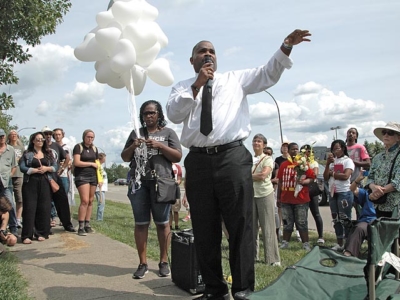Community Solutions seeks input on land west of Yellow Springs
- Published: May 18, 2017
On Saturday, May 20, Community Solutions invites the community to become a part of the planning for the future of the Arthur Morgan Institute’s Center for Regenerative Agriculture, which is the group’s newly purchased 128 acres of farmland on the western edge of Yellow Springs. The planning charrette will take place from 1 p.m. to 5 p.m. on May 20 at the farm, at 131 East Dayton-Yellow Springs Road, just west of the East Enon Road/Dayton-Yellow Springs Road intersection. The public is invited.
The event follows a heady few months of new activity for the Arthur Morgan Institute for Community Solutions, which purchased the farmland at auction in mid March.
“It feels like an organizational leap,” Community Solutions Director Susan Jennings said in a recent interview.
The leap began in February, when word got out that the Arnovitz Farm on the west edge of Yellow Springs would soon go up for auction. However, Jennings didn’t give the auction much thought.
Then a Community Solutions member stopped Jennings on the street with a proposal. What about Community Solutions purchasing the land? The member had money to invest and a vision of the farm as a site on which the group could go deeper into its new focus, that of soil health and sustainability. Still, it was a farm of 267 acres, estimated to cost at least $500,000, and Community Solutions was a quiet nonprofit that held annual conferences on sustainability issues but had never made such a significant purchase.
But Jennings was intrigued. So she took the idea to her board of directors.
“Some boards would say, ‘are you crazy?’” she said in an interview last week. “But this board is entrepreneurial and risk-taking.”
The board said yes. Even more amazing, by the auction deadline a few weeks later, the group had raised the more than $700,000 necessary to purchase the farm. The bulk of the funds came from eight individuals and groups, although many in the community offered additional financial or project support.
“It was hard not to be moved by all that enthusiasm and trust in this vision,” Jennings said. “It set the stage for the community as a vital partner and investor” in the project.
At the May 20 charrette, organizers plan to ask the public, “Do you have research needs that could be met by this sort of space? What are your research questions? How do you envision socially and environmentally responsible land use?” Participants will next tour the farm to consider sites for various farm components.
All of the components have one goal, which is restoring the land through wetlands conservation or restorative agriculture, according to the Community Solutions website. Specifically, organizers hope to include rotational grazing of farm animals, an area for agri-forest, which is the combining of trees and crops, a pollinator garden, a garden for heritage grains, and a garden for a variety of organic vegetables, along with areas for testing in soil sustainability.
Testing has already begun on the farm’s soil for baseline data on soil pH, organic matter, mineral content, agrochemicals, oils, heavy metals, microorganisms and respiration, according to the group’s website. As the fields, which have been conventionally farmed, are farmed organically and the wetlands restored, “the soil tests will demonstrate the changes that occur in the soil such as organic matter content, sequestered carbon, deterioration of agrochemicals and changes in micro-organism life.”
The Center for Regenerative Agriculture project dovetails neatly with the group’s new focus on soil restoration. Long concerned with issues of environmental and social sustainability, Community Solutions held a soils conference a few months ago that captured the attention of many villagers with its emphasis on healing soil as a first step toward sustainable living.
Soils have suffered for the past 70 years, since post-war efforts to increase food production led to agribusiness practices such as extensive use of pesticides, according to the website sustainablefoodtrust.org. As these practices led to more fungal disease in plants, more pests and more weeds, farmers pored on the pesticides, herbicides and fungicides, further harming the soil.
“Seventy years of this kind of farming has so depleted the soil microbiome that in most areas, we now have predominantly dead soil,” according to Patrick Holden, director of the Sustainable Food Trust.
But in recent years, those interested in sustainable environmental practices have reaped the benefits of scientific research in trying to turn soil health around.
“We understand more about the importance of soil, how to build soil structure,” Jennings said. “There’s a lot of exciting research.”
Perhaps not surprisingly, much of the research points to taking cues from past practice. It’s been found to be helpful to replicate the ways that soil thrives in the natural world, such as when different sized plants grow in the same vicinity, and when animals and plants are living together. Such situations create “a lot of redundancy built into the natural systems,” Jennings said, and the redundancy helps create a rich soil structure.
So the Arthur Morgan Institute for Regenerative Agriculture aims to contribute research and techniques for soil preservation.
“We had already decided the most valuable work we can do is to help educate people about soil,” she said. “It’s a new story and also an ancient story.”
At the May 20 event short presentations will be given by a group of soil and agriculture specialists. Peter Bane will speak on permaculture and soil carbon; Glenn Gall on rotational grazing and silvopasture; Kim Landsbergen on soil testing; Dennie Eagleson on phenology; Eric Pawlowski of OEFFA on the biodynamics and organic certification, and representatives from the Nature Conservency will speak on stream restoration and Tecumseh Land Trust on land preservation.
Following the brief presentations, participants will take a tour of the land with one of the presenters. And after the tours, participants will again meet in the barn to consider possibilities.
“We see this as not the end, but the beginning of the conversation,” according to Jennings. “Yellow Springs has so many people with extensive experience in gardening and farming. It’s exciting to provide them with a space to share their ideas.”
Community Solutions also plans a Kickstarter campaign from May 20 to June 20 to help fund some of the farm’s start-up costs, which organizers estimate at around $100,000. For more details, go online to communitysolution.org.
The Yellow Springs News encourages respectful discussion of this article.
You must login to post a comment.
Don't have a login? Register for a free YSNews.com account.
Parkinsons.jpg)













No comments yet for this article.